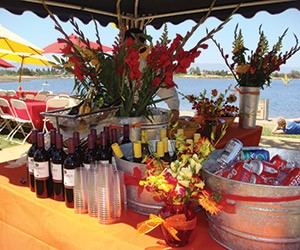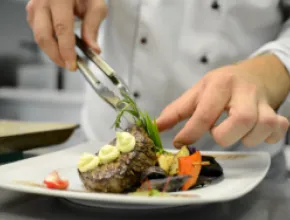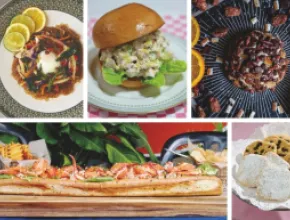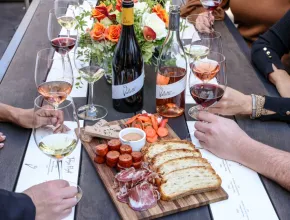Once upon a time, event meals were an afterthought. Attendees could expect rubber chicken, leathery beef or a heap of soggy, overcooked vegetables for the rare soul who was brave enough to ask for something different. Not any longer!
Attendees are foodies and special requests are becoming the norm. It’s not enough that a vegetable or a protein or a dessert looks appealing, it has to taste appealing, too. Ingredients can’t just be fresh, they have to be local, they have to be seasonal and they have to be so memorable that attendees tweet out their joy after the first bite. And all has to happen on F&B budgets that have barely recovered from recessionary lows in 2008 and 2009.
“F&B is not just a meal any longer, it is part of your program and your overall event impact,” says Destination Nashville specialist Carol Norfleet, CMP, DMCP. “F&B can, and should, help drive your overall meeting program and achieve your event goals.”
The scene is similar in California’s Silicon Valley, arguably home to the highest mealtime expectations in the corporate universe. Employers such as Apple, Google and LinkedIn set the standard with in-house chefs and catering departments that routinely roll out special request meals for employees from around the globe. Planners, venues and caterers have to satisfy attendees who are accustomed to demanding, and getting, whatever they feel like eating at the moment.
“The F&B landscape has changed dramatically over the last five years,” says Christina Ferrari, president of Silicon Shores Group, which owns and operates Shoreline Lake, a lakeside event venue in Mountain View, Calif. “We are seeing groups that are 50 to 60 percent vegan or vegetarian or paleo or piscatorian or some mix. That doesn’t even count the ethnic and religious expectations that are part of every group here in the Valley. It is a challenge to make everyone happy and help planners meet clients’ event goals.”
Attendees everywhere understand more about food and are more interested in food than they were 10 years ago, says Tom Walters, senior vice president for F&B Americas at Hilton Worldwide. From New York to Key West, Fla., to Omaha, Neb., 35 percent to 40 percent of attendees routinely make special meal requests. The event budget might call for a standard chicken dinner, but venues routinely prep vegan, gluten-free and ethnic alternatives.
“Creating a positive, memorable experience for attendees is paramount,” says Patrick Cuccaro, managing director of Affairs to Remember in Atlanta. “That includes, perhaps most importantly, a culinary experience they will remember fondly. Conversations about one’s food memories of an event carry great power. You can’t get away with serving a glass of berries to a gluten-sensitive guest when everyone else is getting cheesecake. You need to offer something like a gluten-free chocolate cake with chocolate ganache to create the positive emotions and memories that underline the power and the success of your event.”
Rising Expectations
All of the food fads and trends that are reshaping the restaurant trade are hitting event planners, sponsors and budgets. Farm-to-table. Sustainable. Reduced waste. Healthy. Gluten-free. Food allergies. Seasonal. Food-as-experience. Religious and ethnic expectations. Local.
“Whoever is providing the food for your event has to step up their knowledge base,” Norfleet says. “Telling the planner ‘we do vegetarian’ isn’t enough. What flavor of vegetarian? Lacto-ovo? Vegan? What about fish? You have to talk with your attendees early and often about their food preferences. Younger attendees have been raised as foodies and older attendees have had a lifetime to learn about food.”
Meeting the food challenge starts with knowing your attendees, she continues. Savvy planners are asking for food preferences during event registration. Don’t just ask if attendees have special food requests. Ask about specific requests.
One solution is a checklist of the most common special requests. Some of the more common ones include vegan, gluten-free, vegetarian, lacto-ovo vegetarian, kosher, halal, nut allergies and shellfish allergies. A checklist helps both attendees and planners avoid surprises at mealtime.
Other culinary expectations are harder to assess. There is growing interest in healthier eating, Walters says, but defining “healthier” is a challenge.
“Healthy might mean low salt to one attendee, low fat to the person sitting next to them and smaller portions to somebody across the table,” he says. “Options like a buffet can help meet multiple expectations without breaking your budget.”
Farm-to-table is another hot restaurant trend that is becoming an expectation at events, says Jeff Adam, director of global accounts at HelmsBriscoe. The idea is to source ingredients from local producers, which means fresher, tastier food, a smaller carbon footprint and more local flavors. The reality is more complex.
“In peak season, farm-to-table can mean very good selections at very favorable prices,” says Mike Watterson, director of food and beverage at the Founders Inn and Spa in Virginia Beach, Va. “In the shoulder seasons or in winter, it’s a challenge.”
Watterson’s solution is to partner with local producers and feature them in menus, table settings and event promotional pieces. That gives producers extra marketing reach and tells attendees that event sponsors take food seriously.
How deeply Watterson moves into farm-to-table depends largely on the group. Some planners are focused on the experience, others are looking for the right price point. And sometimes the two come together.
Watterson recently worked with local growers to create “farm stand” fruit displays for breaks at a government-sponsored event. Using whole fruit reduced labor costs, which helped keep food at per diem rates. And the farm stand displays helped give attendees a sense of place.
“Attendees don’t want to see the same-old Danish and coffee,” Watterson says. “They want a sense of place. Especially when you are in a meeting all day, you want a sense of where you are during breaks and meals.”
Farm-to-table is a flexible concept. Local produce is not available all year in most places, but local meat and cheese may be. So are local drinks.
“Our local wineries are happy to work with planners, even doing private label bottlings if the budget allows,” Watterson says. “We have three or four craft breweries within five miles that are a natural for events. Not a lot of planners are in tune with the local growing season, but they are very much in tune with asking us what is possible.”
What Can You Do?
Along with checking attendee food preferences, asking venues and food providers what is possible is the most important step in balancing F&B expectations with F&B budgets.
“Event sponsors and even planners don’t understand the operational costs in F&B,” says Gina Ho, owner of Perfection, an international event company based in Honolulu. “Choices in service levels, chef and food all make a difference in the final cost. It’s a question of how creative the chef can get given your budget.”
A good catering chef can make suggestions like keeping appetizers simple to hold down labor costs, which cuts the total F&B spend. Depending on the local food scene, bringing in an outside pizza or sushi chef could be more cost-effective than having the caterer or venue prepare the same items.
Shoreline Lake chefs deconstruct dishes to meet multiple food preferences. Serving sauces and dressings on the side means the same basic salad works for vegans, lacto-ovo vegetarians and omnivores. Make a vegetarian dish attractive enough and tasty enough and the carnivores won’t care that they’re missing meat. Substituting lamb for pork or beef meets multiple religious and ethnic preferences.
The ultimate solution for picky eaters is to let them do it themselves. Meals are one of the most important networking opportunities, says tradeshow sales and marketing specialist Robyn Davis, founder of WhenINeedHelp.com. She advises planners to designate one night for off-site, small group dinners at local foodie destinations. Attendees sign up for their chosen venue, event staff books the tables, and participants buy their own meals.
“Facilitating a special outing in place of a standard meal caters to your attendees’ personal and professional interests,” Davis says. “And with one less dinner in the event budget, you may have enough to add some extra special elements to your other, on-site meals!”
Fred Gebhart has high hopes but low demands when dining out, and is a longtime contributor to Meetings Focus.
UPCOMING FREE WEBINAR
Saving Money at Receptions | Patti Shock
Wed., June 24, 2015, | 1 p.m. EDT
www.meetingstoday.com/Webinars






